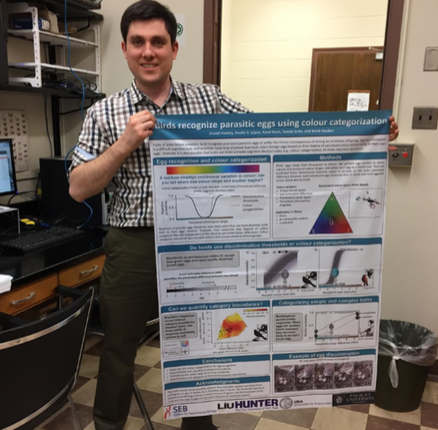By Thomas Gillen
co-Editor-in-Chief
Assistant professor of biology Daniel Hanley is conducting research on how different types of birds, including blackbirds and American robins, detect a parasitic egg in their nest. This is Hanley’s second semester teaching at Post after being awarded a postdoctoral research fellowship at the University of Guelph in Ontario in 2011 and at Palacky University in the Czech Republic in 2013. Hanley earned his undergraduate degree at Cornell University, his masters at Bucknell University and his PhD at the University of Windsor in Ontario in 2011.

Dr. Daniel Hanley in his office in Pell Hall.
Hanley is teaching two classes this semester; General Biology II and Ecology. His two laboratories on campus are located in room 350 in Pell Hall and the greenhouse. While there is no specific course taught in the greenhouse, the space is used for workshops and experiments for his classes. Several students are working with Hanley on their own research projects, including Hunter College graduate Miri Dainson and honors college students Indira Rojas and Ramanpreet Singh, who are both junior biology majors. Hanley is also mentoring Palacky University student Karel Gern. All of the students are earning credit for their work and are working on separate projects that are similar to Hanley’s research. Rojas is researching how the color of birds’ eggs has evolved over time and Singh is researching the evolution of color in plants.
Hanley has been studying the colors of bird eggs since 2004 and brood parasites since 2011. His current research on brood parasites began after his postdoctoral work. “After earning a PhD, you get a position that is kind of like a faculty position where you’ll teach and do research,” Hanley said. “A ‘postdoc’ gives you a little bit more freedom than the typical academic position, so you can teach some classes when you like or do research 100 percent of the time. You have a lot more freedom to do whatever you need to do for your professional development.”
Originally from Lagrangeville, New York, Hanley wanted to work with animals from a young age, first as a veterinarian. He worked at a fish and wildlife center as a teenager, and this job opened other doors for Hanley as he proceeded to work at a bird-banding center in Millbrook, New York. Bird banding is the process of attaching a metal or plastic tag to the leg of a bird in order to identify it and track its movements. Hanley worked at the center as a volunteer through high school and graduation before becoming a primate caretaker at the Trevor Zoo in Millbrook.
Concerning his experience there, Hanley said, “primates are very unpredictable. While at the zoo, I took care of brown capuchins, and the small ones would always try to put monkey chow in your pocket as you walked by. They would also try to grab our keys when we were cleaning the cage because they saw it as an object of value. So to make them happy, we bought Fisher-Price keys and let them play with it while we were cleaning.”
The goal of Hanley’s research is to gain “a better understanding of the recognition mechanisms in birds” in how they detect their eggs. He chose to conduct this particular research because this question hadn’t been addressed before, and it can change “how we understand how birds’ view perception.” While Hanley is not writing a book on his research, he plans to publish a peer-reviewed paper. Hanley wants readers to understand “how important it is to consider the sensory perception and cognitive process of birds and consider what is happening in their eyes and brain when they detect their eggs.”




Be First to Comment